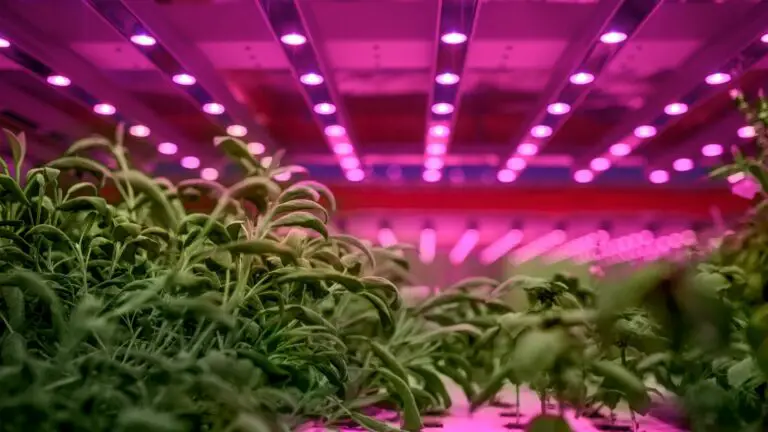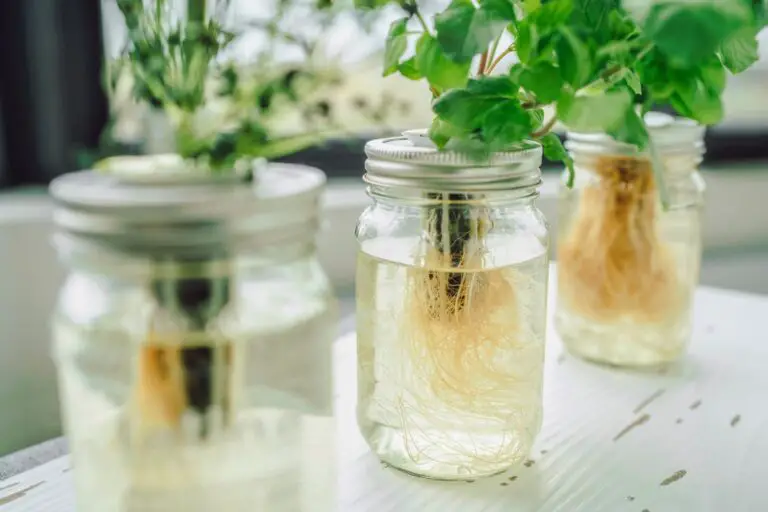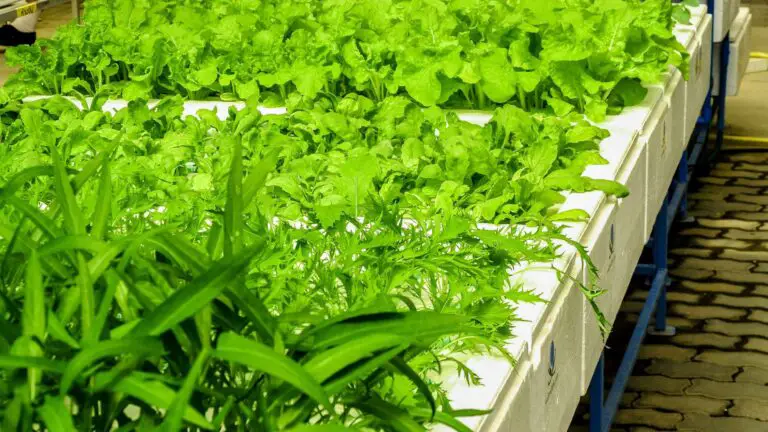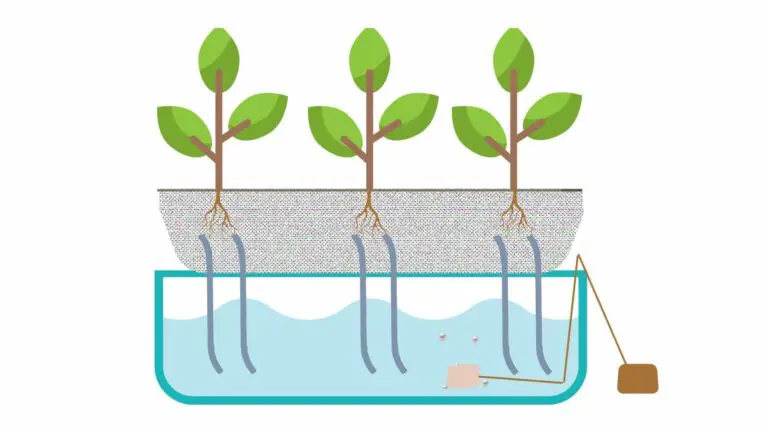How Deep Water Culture (DWC) Hydroponic System Works?
Disclosure: Your purchases through our links may earn us a small commission, supporting our site’s ability to provide valuable information to our readers. Rest assured, it won’t impact your price. Thank you for your support.
Many people are turning to hydroponics as a sustainable way of growing produce for their families.
Sustainable hydroponics is one of the most important methods for the future because it uses less water than other methods.
A Deep Water Culture Hydroponic System, also known as a DWC system, is the simplest and easiest way to grow plants.
Deepwater culture is one of the most sustainable hydroponic systems because it uses less water. This system, also known as a DWC system, is the simplest and easiest way to grow plants. This system is perfect for people who want to garden and produce their food!
You can use this system to grow various fruits, vegetables, and herbs. Deepwater culture is easy to set up and doesn’t require a lot of space. You can even use it in your backyard!
This blog post will talk about what Deepwater Culture Hydroponics is and how it works!
Related: How to Set Up a Deep Water Culture (DWC) Hydroponic System?
How Does DWC Work?
Your plants sit directly into the water that has been added with nutrients for them to drink up as needed.
The oxygenated water will provide everything your plant needs, so there is no need for soil. Instead, you will be adding mediums like perlite, Rockwool cubes, or coco fiber which act as both excellent growing materials and anchor the plant in place.
The air stones oxygenate and agitate the water, which helps to keep your plants healthy! The air stones also help to prevent any build-up of salt on your growing mediums.
Further, the roots of the plants grow through holes in mesh pots that you place into a floating raft made out of Styrofoam or plastic. This allows oxygen from outside to get inside to breathe properly while also getting nutrients and minerals directly from the nutrient solution below them by using capillary action.
The water level is not the same all around your plants — instead, it’s lower where they are growing!
Advantages and Disadvantages of Using Deep Water Culture System
Advantages
Deep Water Culture type hydroponic system has the following benefits over other types of systems:
- It is a very simple system to set up and use. You can use any type or size of the container as long as it has a top that will fit tightly.
- You can set up this system indoors or outdoors.
- It is one of the most productive types of hydroponic systems.
- The plants are suspended in nutrient-rich water, so they get more light and oxygen than in other types of systems.
- There is less chance of disease and pests affecting the plants.
- It is effortless to maintain, and it requires very little time and attention from you!
- You don’t need a lot of space either — even if you live in an apartment, you can still use a Deep Water Culture Hydroponic System!
Disadvantages
The main disadvantages of the deep water culture system are:
- The nutrient solution is virtually still, leading to bacterial growth, algae growth, and fungi and molds. The nutrient-rich water can cause problems with the pH level and requires regular monitoring.
- A simple air pump does not provide good aeration, leaving some plants without adequate oxygen. Therefore, buy an air pump fit for the system.
- The best place for the air stone is in the middle of the tank, but plants around the edges will not get their fair share. If we add airstones in corners, it will also help to avoid the problem.
- It isn’t easy to clean the tank or container thoroughly when it is not used.
- Some plants cannot stand having their roots “wet” all the time and may rot if this system is used.
Related:
6 Easy Steps to Prevent Algae Growth In Rockwool
The “Weed” in Hydroponic: 3 ways to avoid it
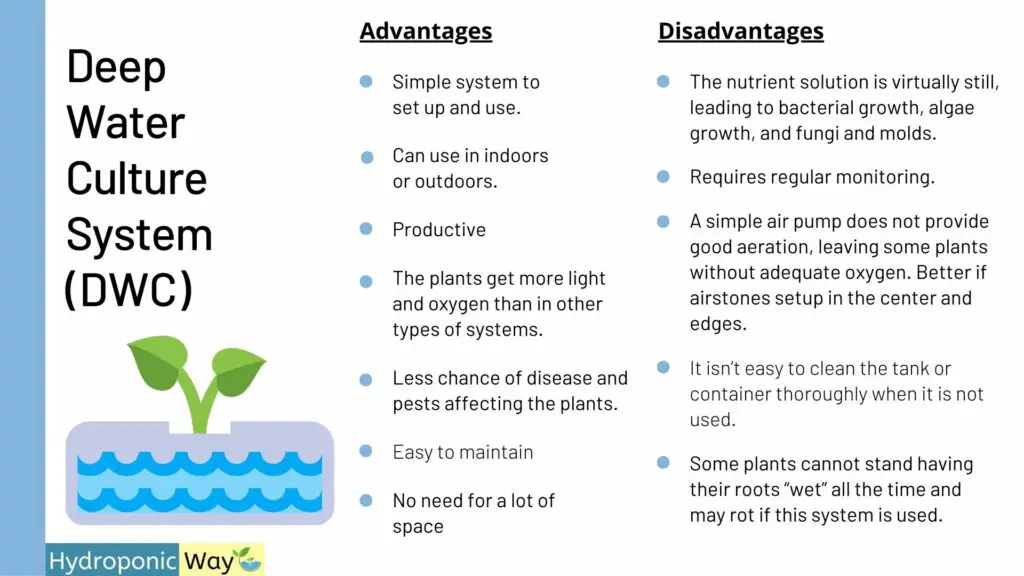
How Many Plants Can You Grow with DWC?
You can use this method of growing in small spaces! If you are only planning on growing one plant at a time, then a five-gallon bucket will work best.
If you need more room for multiple plants, try using trash cans instead! The space you will be using depends on what type of product or herbs you’re trying to grow.
Some Tips for Doing Deep Water Culture Hydroponics
- Do your research — figure out what plants you want to grow and learn their water and nutrient needs.
- Get a powerful pump — the bigger your deep water culture system gets, the more powerful your pump will need to be.
- Use the correct nutrients for your plants and follow the directions carefully.
- Mix up your nutrient solution and adjust it as needed.
- Clean out old solutions regularly and keep an eye on pH levels and nutrient levels.
- Ensure there’s enough oxygen in the water and that the growing medium doesn’t get too soggy.
- Keep an eye on water levels and top off when necessary.
- Establish a routine for checking on your deep water culture system and be prepared to make changes as needed.
Related: 10 Tips for the DIY: Deep Water Culture (DWC) Hydroponics Systems
Conclusion
It might seem not easy, but it’s not — anyone who has even had a garden before could do this!. It is especially great for beginners because they are easy to set up and doesn’t require much maintenance!
Using this system, you can have fresh and locally grown food year-round (even if it’s winter or summer!).
You will need to check on your plants regularly, but other than that, it is a very low-stress system!
There are many parts to a Deep Water Culture Hydroponic System, but they all work together to make your plants grow successfully!
If you’re looking for an easy and sustainable way to garden, then Deep Water Culture Hydroponics is a good choice!
So now that you know all there is to know about Deep Water Culture Systems, it’s time to get started on your own!
Thank you for reading
If you loved this one, you may also check out other stories in Hydroponic Way.
How to Setup Wick Hydroponics System With 8 Easy Steps.
The Pros and Cons of Wick Hydroponic Systems
Pros and Cons of Drip Hydroponic System
How to Grow Hydroponic Tomatoes for the Absolute Beginner?
If you are looking to buy complete kit for Deep Water Culture hydroponic system click this link to select the best one suited for you.


